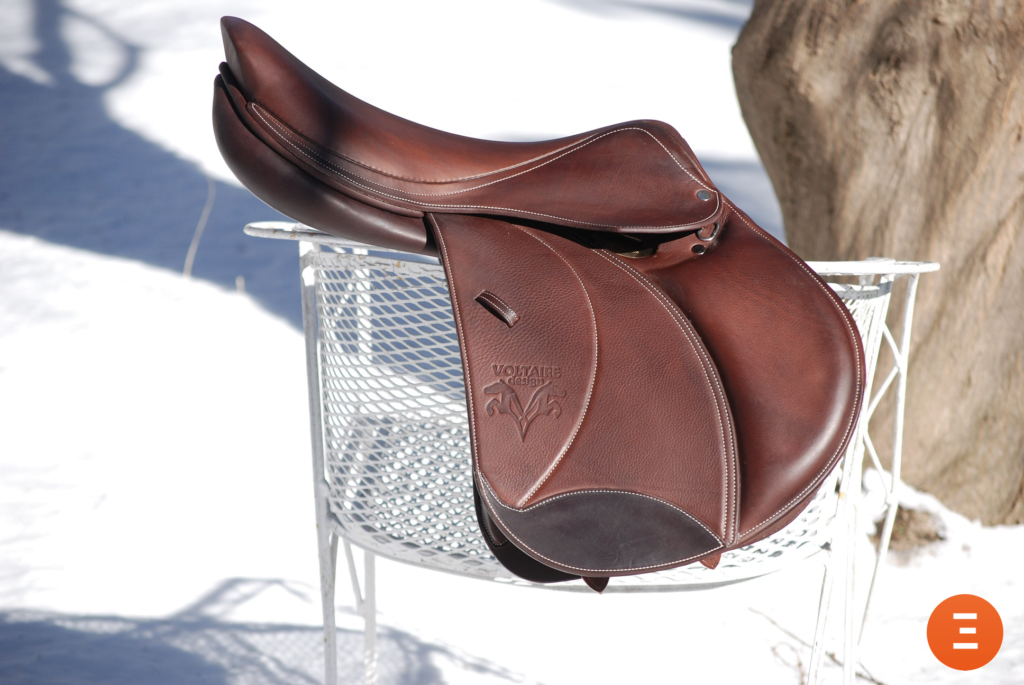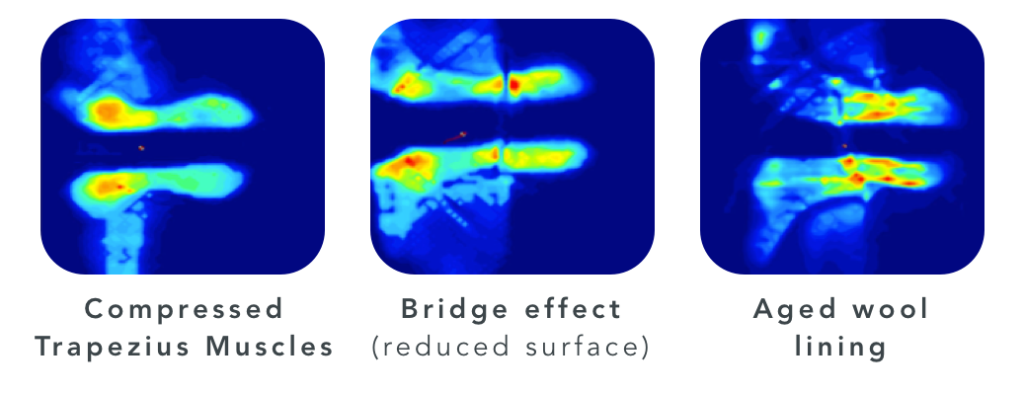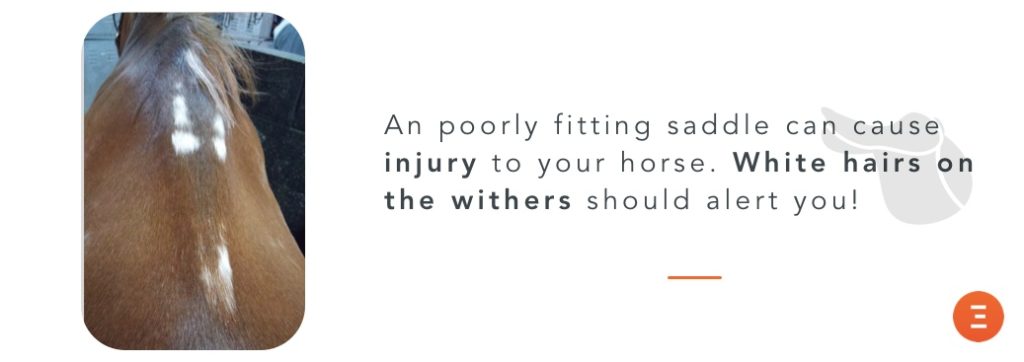
What are the Consequences of a Poorly Fitting Saddle?
If we tell you that 90% of French riders have a poorly fitting saddle, do you believe us? And you, are you sure that your saddle fits perfectly? Take a look at the advice of Annette Rancurel, saddle fitting specialist, to choose the right saddle.
Just like with the bit, we tend to not pay attention to our saddle. However, it plays a key role in our horse’s performance and well-being. Camille Saute, biomechanics engineer, and Annette Rancurel, saddlery engineer, explain why.

We have a lot of Equisense Motion Sport users that report how much their symmetry grade changed after having changed their saddle (+2 points with a good saddle, -2 points with a “bad” one). That’s why I thought it might be a good idea to tell you everything you need to know about the saddle.

How to know if the saddle fits? Why is it important to adjust one’s saddle? Together with our expert Annette, we give you all the answers.
Table des matières
The two functions of the saddle
1/ Distribution of the pressure
The main goal of a saddle is to evenly distribute the pressure generated by a rider.
As explained in the article on bits, pressure is force divided by the surface. To explain it simply, here the pressure is your weight plus that of the saddle. The larger the contact surface on your horse’s back, the lower the pressure.
When you’re riding bareback, the contact surface is just the surface of your rear end. The surface area is small, so the pressure is very high. When you’re in the saddle, your weight is distributed across the entire surface of the panels. The pressure is much less, and your horse is much more comfortable as a result. I don’t mean you should never ride bareback, but just that it should be done within reason. The saddle distributes pressure across the back while keeping weight away from the entire length and width of the horse’s spinal column.
2/ Helping the rider balance
The saddle serves another purpose as well. It lets you stay balanced and vertical without getting tired. What’s more, the saddle and the reins are the only things that separate you from your horse. So, if you want a clear line of communication between you two, a saddle that fits both you and your horse is absolutely necessary. It’s the saddle that transfers the information from your hips and torso to your horse. If the information is impeded in some way, it stands to reason the message won’t be correctly received.
The problem is that the saddle, despite all the important functions it serves, can do much more harm than good when it doesn’t fit.
The 3 types of poorly fitting saddles
First, let me clarify. There are three types of “poorly fitting” saddles.
1/ Poorly designed saddles
Imagine having to wear a pair of plastic opaque eyeglasses with one temple that’s longer than the other. No matter how hard you try, there’s not much to do. You’ll never see well, and they’ll always be uncomfortable.
⏩ You should then get rid of these saddles.
2/ Good but poorly fitting saddles
Poorly adjusted saddles are like a good pair of glasses that don’t have the right prescription. It’s not pleasant, but it’s a problem that can be solved.
⏩ Depending on how badly the saddle is fitting, it can be corrected thanks to a compensator or a saddle remodel. Otherwise, you have to change the saddle.
3/ Good but badly placed saddles
Finally, good saddles that aren’t in the right place are like if you had a good pair of glasses with the right prescription but wore them at the tip of your nose. They are very good but as they are badly placed, the temples hurt your ears, it pinches your nose and it does not correct your sight much when you look straight ahead.
When the saddle is badly placed, it is usually because it has been put too far forward. We rarely tend to put it too far back. This will interfere with the movement of the shoulder blades and therefore reduce the amplitude of the stride.
What are the consequences of a poorly fitting saddle?
More concretely, a poorly fitting saddle:
- doesn’t distribute pressure correctly
- rubs or cuts into the horse’s back
- stores up heat.
In terms of pressure, a poorly fitting saddle will result in areas along the horse’s back that receive substantially more pressure. For example, if the gullet is too narrow, the saddle will create pressure points up and down the spine.

If the opening of the gullet area is too narrow, there will be pressure points all around the withers. The effect is a bit like a clothes pin, it is very painful for the horse.

However, if the opening of the gullet is too wide, the saddle will tip forward and crush the withers (ouch). At the same time, the cantle will pop up and shift from side to side every time the horse moves, causing severe chafing.
If the saddle panels are angled too sharply, the contact surface will be less, placing a significant amount of pressure on each side of the spine. And so on.


The pressure pushes the horses to arch their back
It’s important to note that pressure causes the back to extend. Have you ever seen a veterinarian test the mobility of a horse’s back by pressing his or her fingers on one side of the spine? The horse immediately hollows his back, and the reaction can be quite intense. Now, imagine your saddle is pressing on the same point. Your horse would have a hard time staying soft and supple under such conditions.
The consequences on the horse are huge
The movement is impacted
First off, a saddle that doesn’t fit your horse is going to significantly impact the movement.
A study (Peham, 2004) looked at the effects of poor saddle fit on a horse’s motion and found horizontal speed and acceleration as well as acceleration across the diagonal was significantly more variable. Because the horse is uncomfortable, it will look for any way to relieve the pressure and therefore will be incapable of moving in an even and stable manner. It’s difficult to advance in the levels and progress normally when the horse cannot move out evenly.
The anatomical structures are damaged
The saddle comes into contact with many anatomical structures that must be protected, including the spine. There should be no pressure on this particular part of the body no matter how the horse is moving (flexion, extension, bending, and rotation). The muscles of the back and scapula (shoulder blade) can also be hindered by the saddle. Excessive pressure prevents blood from circulating through these structures and compresses the horse’s muscles against its skeleton. It’s important to know that pressure-induced pain quickly becomes unbearable. As a result, the horse becomes numb.
The horse’s musculature can become asymmetrical if excessive pressure causes the muscles to atrophy. In turn, this can result in a sore back or even lameness. (Greve, 2013; De Cocq, 2004). In fact, did you know that poorly fitting saddles are the primary cause of back pain in sport horses (Jeffcott, 1999)?
A poorly fitting saddle can injure your horse

Finally, saddles can also cause visible injuries. These are the famous wither marks that cause people to say, “Oh, this horse is ridiculous, he’s constantly injuring his withers!” The appearance of white hair along the withers should be a major warning sign!
Conclusion
The negative consequences of a poorly fitting saddle or an incorrectly placed saddle are well known. When we see that some users of Equisense Motion Sport have gained up to 3 points of symmetry by adapting their saddle, it confirms that the subject is far from being trivial for the horse.
It’s an expensive part of the equipment, of course. But if there is one element on which you should not try to make savings, it is the saddle! So check if your saddle is well adapted, and get a professional to help you if it is not the case!
📚 Read as well: How to know if your saddle is well fitting?
Would you like the help of a Voltaire Design saddle expert to find the right saddle for you and your horse?
Click on this button:
Finally, I would like to thank Annette for her time in writing this article.
See you soon for a new article,
Camille Saute